Executive summary
The entire plan is going to be prepared on two innovative kitchen appliances, namely, smart oven as Easy Oven and slow cooker as Easy Cooker and these products will be manufactured by a new venture named as the XYZ Company. The venture description will point out some specific features of the business regarding its ownership style, location, offered items, service orientation, capitalization, and environmental situation. The background analysis will reveal all facts associated with the kitchen appliance industry of Australia based on some initial evaluation theories on SWOT, PEST and Porter’s 5 forces model of competition. The marketing plan is one of the most significant part of the plan for the exposition of positive and negative and challenging aspirations of the duet brands, subsequent pricing policy as value-based pricing for penetrating the market, comparative position on a BCG framework, projected segmenting, targeting and positioning strategies, core positioning statements, promotional strategies etc. The financial plan will elaborate the predicted balance sheet and income statements for 4 fiscal years along with a projected break-even chart. Finally, the risk assessment section will disclose some of the integral risks and pressure affecting the business as well the cookeries as a whole.
Company overview
The XYZ is an Australia based kitchen appliance company that has been established on June 1, 2010, ABC Road, Sydney, Australia. The basic purpose of establishing such kind of appliance house is to introduce two dynamic and diversified patterns of cooking tools with homemakers and others who frequently need and love to cook delicious food within shorter period. These two new items are a smart oven named as “Easy Oven” and slow cooker as “Easy Cooker” which have been designed exclusively with some general and sophisticated service specifications including replacement and warranty facility. The three entrepreneurs have recently graduated from LIC University, UK in Home Economics have initiated the company. They have formed this business on partnership basis with a total investment of £1000000 that has been financed jointly by an Australian NNP brand on 70%- 30% bases for running the business for the next 4 years. Targeting Australian single men as bachelors, single mother and working women who have adequate interest in preparing tasty foods but cannot invest enough time in lengthy cooking procedures, the company is going to induce itself at a single rented showroom and necessary internet infrastructure for making both online and off- line sales.
Industry analysis
In Australia local currency, there are huge number of multinational companies’ are active in the market with quality kitchen appliance including the oven and cookers when there are also some other local companies who produces kitchen appliances. The major players of this market with their market share are as follows:
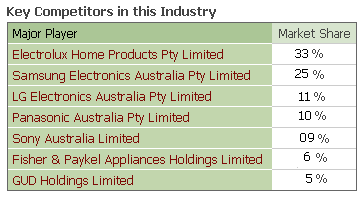
The product line of kitchen appliance is starts from rice cookers to ovens, mixer etc. The current kitchen appliance product available in the Australian market is as follows:

The kitchen appliance industry in Australia generates $8332 million in year 2009 and shows a growth rate of 1.1%. The possibilities of further growth is high because due to the resection people are not willing to go to the food court and try to prepare food at home. As a result the demand for kitchen appliance increasing rapidly. Bell (1997) argued that the gross product of this industry is $912 million and the number of establishment is 925, and number of people worked in here is 6209 units, which shows the scale of operation of this industry.

Environmental Analysis
The business environment of XYZ Company for their new product Easy Oven and Easy Cooker comprises of the demographic, legal, economic, and other related issues, which directly affect the business activities regarding the penetration with their new product in the market of Australia. In this segment, various components of the environment have been analyzing to understand the market condition in the selected market.
- Demography and population: Australia is a well-developed country with its population of 21,262,641 in July 2009 and ranked as world’s 51st country regarding population. In this population, the age group ranged from 16 to 65 comprises of 67.9% percent of the total population. These persons are the target groups of XYZ Company who are tend to buy home appliance products. Therefore, this market is very lucrative in business sense as this a very big market for the kitchen appliance especially oven and pressure cooker.
- Economy: Australian economy has a strong base depends on its current GDP of US$ 1055.9 billion in 2009 which shows a growth rate of approximately three percent. The per capita GDP of the country is US$36,226 in the year 2007 and total revenue is A$319.46 billion. Its public expense per year is nearly A$292.47 billion, which shows a great opportunity for new company to enter in the market.
- Technology: Australia is a country where the technological development is identical with new modern advancement of technology in the world and almost in every sectors, technology takes the major role for development. In case of kitchen appliance, technology is mandatory as these products are building on the modern technology and the customer feel easy to use this product with new technology.
- Legal concern: Australian legal system is much more similar to the British law and it adopted the legal system, which is consistent with the modern legal system of the world. Regarding the business and industry, the country introduces contract law, copyright law, and other system, which are friendly to both producers and customers.
- Industry Demand: Australia has an economy based on service industry where it contributes approximately 52 percent of the total GDP and the manufacturing industry contributes 26 percent of the GDP. The total consumption of industrial goods rate is high. The main customer of the kitchen appliance product is middle age group. The economic downturn causes customer to limiting there access to the restaurant and causes high demand for kitchen appliance.
- Competition: In Australia, Australian companies as well as other multinational companies and brands produce or distribute the kitchen appliance products in the market. The key player in the market includes Electrolux Home Products, Rheem Australia Pty Limited, Fisher & Paykel Appliances Holdings Limited etc. that cover the total market of kitchen appliance market.
Mission
Mission of the company XYZ is deals with the current activities. Existing industry scale is focused here significantly. According to the business plan, the XYZ is now aimed to launch kitchen appliances in Australia. Here, product type is involved in easy oven and easy cooker and target market is the household of 24-52 years old. Another aim of XYZ company is that they tried to overcome current economic downturn of the kitchen industry within 2011 (David 2002).
Vision
While mission of the XYZ is executing existing activities, vision is outlined for upcoming functions. Concentrate on four major areas sequentially as- selection of target customer, technology adoption, selection of regional spot and product line vision is formulated for next five years. In short, what will be their target position is presume in this section. More specifically, the XYZ would like to achieve 5% market share in this sector within 2013. On the other hand, probable cash assessment at the conclusion of the year 2013 will about a significant part of $3.6 billion. (Kotler 2004, pp. 102-109)
SWOT analysis of the XYZ Company
By this analysis a number stronger, weaker, scoping, and challenging issues of those kitchen appliances will be revealed, as below:
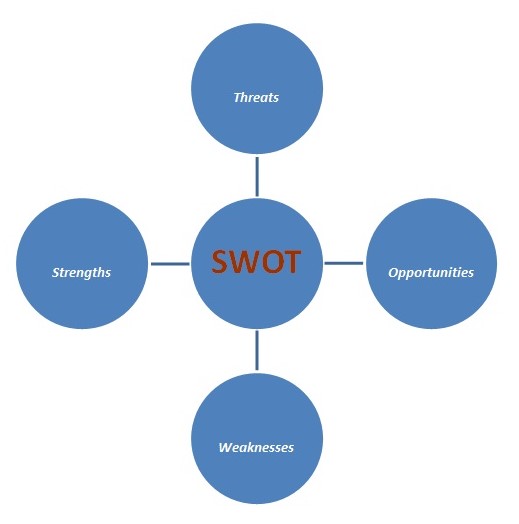
Strengths
Several stronger issues are:
- Easy and safe to use.
- Overall dimensions, weight, mode, and features are suitable enough for baking in Easy Bake.
- Easy function and energy savings facility
- Use of durable stainless steel for warming.
- Use of innovative technical knowledge in featuring both products.
- Facility of cooking a number of items in a single cookery;
- Automated functionality in adjusting heat.
- Enrich configuration than existing similar products.
- The 3 distinct heating system of the slow cooker will allow anyone to cook at a faster rate.
- Effective promotional and advertising movement
Weakness
Some vulnerable criteria are:
- Handling of a complex electronic appliance is a reluctance issue for many housewives;
- Requires putting far away from children to avoid accidents.
- Managerial inefficiency
- High cost of production
- Confusing strategic management
- Poor supply chain management
Opportunities
Several optimistic cases are:
- Gradual expansion of target market would increase the demand and growth.
- Completely nationally designed feature would emphasize public sentiment to buy national.
- Growing interest of using electronic goods in kitchen.
- Optimistic image in customers’ mind
- Entrance of new consumers group
- Shift in alternative product
- Elastic trade policies
Threats
Some pressuring factors are:
- Lower customer confidence about a new kitchen appliance brand.
- Pressure from mega established global and domestic brands involving Samsung, Philips, Pulse Home Products, and Murphy Richards etc.
- Progress technology
- High negotiation supremacy both of purchaser and provider
- Economic down turn and high inflation rate
- Expensive monitoring necessity
PEST analysis
XYZ Company’s macro environment includes the political factors, economic factors, social factors, and technological factors in Australia:
Political Factors: David (2002) argued that the political factors consider several issues, for example, the tax policies, government system, employment laws, environmental rules, traffics, political stabilities etc of Australia. Australia has free trade agreement with the other countries and the restriction is very limited in the country. The political stability is another advantage of doing business in Australia. There are various laws regarding the issues of employment in the country and it ensures equal opportunities for man, women, and equality among the various races and religions. Regarding the environmental issues the country is very restrict and no industry can pollute the environment.
Economic Factors: The economy of Australia is very strong in a sense of total GDP, per capita income and other related index. The expenditure patterns of the people are also positive for establishing new business in there. The total GDP of the country was US$1055.9 billion in the last year, per capita income of the people was US$36,226, and the growth rate is 0.2%. The inflation rate is very nominal as only 1.5 percent and the workforces comprises of 10.844 million. This economic condition shows a very good prospect for XYZ Company to start with their new products.
Social Factors: The social factors in Australia include the age groups of the country, health consciousness, population growth rate, career attitudes, and emphasis on safety etc. The birth rate of the country is 13.8% whereas the death rate is 7.56 %. The major age group ranged from 15-65 consist of two third of the population. The health consciousness is very high in there as the life expectancy rate is likely to 81.2%.
Technological factors: Hitt, Ireland & Hoskisson (2001) stated that technological factors cover R&D action, automation, technology incentives, rate of technological change etc. Australia as a first world country with its strong economy also very advance in technology. All technological advancements are take place in Australia and this technological change is very important for XYZ Company because they want to introduce product with technological attachment.
Porter 5 forces
Porter (2004) argued that market environment should assess by following five sectors and these are:
Industrial Rivalry: In the kitchen appliance industry of Australia, there are some big national and multinational companies, which are fighting in the market for the market share. These companies have their product quality and brand equity in the market. IBIS World (2009) mentioned that these companies include Electrolux Home Products Ltd, Rheem Australia Ltd, Breville Group Ltd (BRG), Samsung Electronics Australia Ltd, LG Electronics Australia Ltd, Barbecues Galore, Panasonic Australia Ltd, Sony Australia Ltd, Fisher & Paykel Appliances Holdings Ltd, GUD Holdings Ltd and so on
Besides national companies, many international companies entrant in this market and most of these companies compete in the market either on price or on quality or on both. For XYZ Company, it is little tough job to enter and sustain in the market if they cannot afford high quality oven and cooker with a price lower than the competitors can.
Threat of Substitutes: The products XYZ Company select for their target market is Easy Oven and Easy Cooker, which are already available in the market. The technological advancement creates this products substitute to the traditional appliances of kitchen. In this industry the threats of substitute product is low as because this oven and cooker updated with the technological change such as microwave oven substitutes the electric oven. So here, the risk of substitute product is low for the XYZ Company
Buyer Power: IBIS World (2009) mentioned that the power of the buyer of household cooking appliance in Australian market is low as there are many buyers for the products of a number of companies and there are two categories of customers for these kitchen appliance, one is home users (24-54 aged group), and other is business users. The target customers of XYZ Company are the home users and the user segment is large enough for the company to market these products. Nevertheless, in presence of a numbers of sellers the buyer can test the product why buying the product regarding quality and price
Supplier Power: Bell (1997) argued that the power of suppliers in kitchen appliance industry is very high as most of the products reach to the customer through the hand of the suppliers and the foreign producers of oven and cooker relay heavily on the supplier for market their product in Australia. Local producers also depend on the suppliers for both raw materials and finished product. For XYZ Company, they need to crate a strong supplier base for market their product and the supplier’s margin should increase to attract strong suppliers for these oven and cooker.
Threat of Entry: The barriers to entry in kitchen appliance in Australia are very low, as the government of the country imposes no restriction to the new entrants to enter in the market. Therefore, XYZ Company easily enters into the market with their Easy Oven and Easy Cookers. The problem is that the existing manufactures or suppliers grab the market with their product and they have the brand image in the market. Another issue is that the existing competitors achieve the economic of scale, so that they offer the product with low price, which hinders the way of new entrants like XYZ Company.
Market testing
Market testing refers to the testing of new product or idea in the market before finally takes the decision of production or marketing of product. Market testing is necessary because it justifies the decision in real sense and reduces the risk elements of an idea. XYZ Company wants to introduce Easy Oven and Easy Cookers in the market and it can test the market before bringing the product in the market. XYZ Company can test the market in following ways:
- Before final production, XYZ Company can develop prototype of oven and cooker and demonstrate it to asses the acceptability to the customers.
- The company can determine the exact price of the oven and cookers by examining the price of the customers.
- XYZ Company can go to the customers in Australia with the prototype and ask them whether they want to buy oven and cooker or not. If buy then what price they want to pay.
- XYZ Company can make a comparison of its product with the existing product in the market.
- The company people can participate in exhibition or trade shows to display its product where it can get immediate feedback from the customers.
BCG matrix
It is a portfolio planning technique for evaluating the intended appliances in terms of relative market growth rate and relative market share by exposing 4 different criteria among which the projected cookeries are expected to achieve the following position (Kotler and Armstrong, 2006):
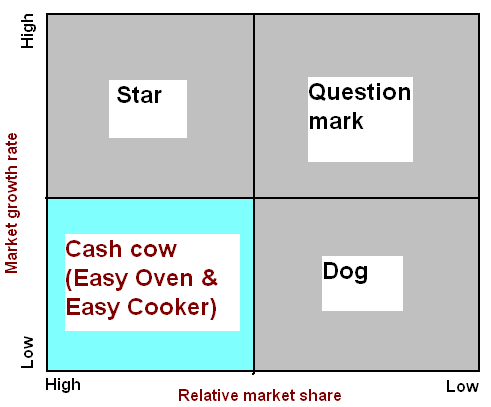
- Stars: Stars are high- growth, high- share businesses, or products;
- Question marks: Question marks are low- share business units in high- growth markets.
- Dogs: Dogs are low- growth, low- share businesses, and products;
- Cash cows: Easy Oven and Easy Cooker have been placed in this segment with an expectation of gaining comparatively high market share associated by low growth projection by producing adequate cash.
Competitive Advantages
XYZ Company must have competitive advantages to compete in the market, as there are a number of competitors with their strong customers and products base. The company currently plans to bring two products in the market, which are the Easy Oven and Easy Cooker. To get the competitive edge in the market XYZ Company has to focus on two issues as cost minimization and product differentiation. The company has to use its resources and capabilities fully to realize these advantages.
- Resources and Capabilities: To get the competitive edge in the market the resources and capabilities of XYZ Company must be superior to the competitors in the market. Otherwise, the competitors simply imitate the resources of the company. The company can use some specific resources, which are difficult to imitate by the competitors. Hitt, Ireland & Hoskisson (2001) argued that resources could be patents and trademarks, proprietary expertise, Installed purchaser base, human resources, corporate social responsibility, strategic management system, reputation of the firm, brand equity and so on. As resources refer to the capabilities to use the capital in a way that brings advantages to the company over the rivals, the XYZ Company can bring oven and cooker in the market at a price lower than the competitors of Australian market can.
- Cost Advantages: Currently in the market, the oven product price ranged from US$200 to US$500 based on the different categories of the oven. XYZ Company needs to provide oven and cooker in the market such as within $200.
- Differentiation Advantages: XYZ Company must add some special features in oven and cooker than the competitor’s one so that they can realize the differentiation advantages in the market.
- Value Creation: With the advantages of cost and differentiation, XYZ Company should create a supplier network for the raw materials and the finished product for value creation. Every operation of the company must add some value for competitive advantages.
The STP strategy
This strategy is composed of segmenting, targeting, and positioning of the new kitchen alliances (Kotler & Armstrong, 2006); it is being described as below:
Market segmentation: It involves dividing the larger, heterogeneous market into smaller segments effectively and efficiently so that the selected appliances can match its unique needs. Among a number of alternatives, the company will use geographic, demographic, and behavioral segmentation. Geographic segmentation will focus on serving the products only to Australian customers while demographic segmentation considers several variables regarding age and life cycle stage, gender, income, family size and occupation. Finally, behavioral dividing incorporates occasion, south benefits, usage rate and loyalty status and rate of using.
Market targeting: Here, the XYZ Company will consider several factors for evaluating the market regarding segment size and growth, structural attractiveness along with organizational resources and objectives. In selecting target market segments, it will use undifferentiated marketing strategy for targeting the whole market with one offer in terms of targeting the common needs of target audiences for a quicker and tasty cooking option associated by diversified services, capacities and accessories including pizza pan, baking pan, grill pack and so one. In general, the company is interested to serve its duel products to Australian people only who are working and single women and men generally feel hurry in cooking.
Market positioning: Through positioning, customers could remember the products on important attributes like- quality, durability, serviceability etc.
Positioning maps: It will show the perceptual positioning of the brands in relation with other market competitors, such as:
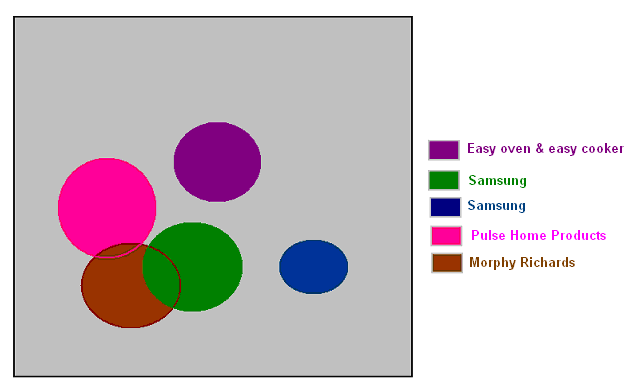
Choosing a positioning strategy: It is a multi- phased task, as:
- The appliances will incorporate various competitive advantages regarding product, service, and channel differentiation by offering distinguished attributes, warranty and repair option and transaction through physical and virtual channels.
- In choosing the right competitive advantages, the company will focus on important, distinctive, superior, affordable, and profitable aspect of the brands.
- In selecting an overall positioning strategy, it will consider 5 value proposition criteria among which it will go for more for the same option, as:

Lastly, the company will develop a positioning strategy as: “Easy cooking, easiness of life”
Size and scope of the venture
The company will primarily start its operation with £1000000 in cash and its central office and showroom will be located on a rented space of 100 square meter situated 3rd floor of a private commercial market of ABC Road. This market occupies sufficient parking, sewage, plumbing, gas, electricity, air conditioning, lift, and elevator facilities. Additionally, The XYZ will engage adequate management and maintenance staffs for proper daily operations and customer service. It will also deliver services through developing a standard and interactive web site which involve several options regarding selling, company information, product information and features, pricing, cautions in using, promotional messages (vary from time- to- time), product display, FAQ (Frequently Asked Question) by regular or potential users and suggestion box where customers can put their perceived suggestions about the cookeries as well as complaints and usage instructions.
Product description
Easy Oven: It is a purely Australian design developed on IQ™ technology with a dimmer switch for dispersing heat for required cooking. Other features are:
- Specialized racks to auto- ejecting halfway in opening its door.
- Stainless – steel body occupies a top that replicates as a warming tray with nonstick pizza, baking and grilling rack.
- 2400 watts for power, 22 litre capability, time dial, and automated stopping, 2 years warranty associated with other accessories (Mintel report 2009).
Easy cooker: It is an Australian high duty Quantanium covered insert pan like a slow, stovetop or oven as sear, slow cook and serves in a single pan. Others are:
- 7 liter (Family size);
- Automated functions.
- Non- stick, detachable duty EasySear pan for cooking and roasting.
- Heat protective silicon handle and stainless steel cover.
- 1-year replacement assurance (Mintel report 2009).
Marketing Strategy
Market strategy is composed of three essential factors- division of the market, goal fixing, and finally market evaluation. First, division of market is assembled through both of target people and regional location. In this case, Australian households are chosen. Second, goal fixing stage pacts by the long term business activities as well as fulfill the target earnings. Third, market evaluation is future judgment of the XYZ company picture from viewpoint of the consumers. In contrast, easy oven and easy cooker are the multiple options for the Australian households.
Pricing Strategy: pricing strategy is another vital dynamic of any company’s survival as well as the XYZ. By following sequential steps as described in below the XYZ would outline a sound pricing image. In addition, it has to consider that overall pricing strategy of the XYZ grounded on value as well as market penetration. (Schaper & Volery 2007)
- First, focus on the pricing goals of the XYZ Company.
- Second, demand evaluation is one of the major issues to select price.
- Third, manufacturing or the production costs computation
- Forth, enquire and examine competitors’ pricing hierarchy such as- production costs, product price, promotion approach etc.
- Choose a specific pricing system or technique.
- Finalize price amount for the target consumers.
Business level strategy: on behalf of individual business function, business level strategy of the XYZ is examined arrangement of the managerial amusement. In this strategic part, performance evaluation of the operation mangers is grasped by utilizing a set of tools. Availability of competitive advantages and handsome range of production fortify the business level strategy. On the other hand, less competitive improvement would be weaker the XYZ. Key tasks of the of this stage are- sketch the industry transformation modes, economic dynamic execution and survival growth of the XYZ company. Overall business-level strategy management of the XYZ is plotted in below. (Kotler, 2004, pp. 307-385)

Promotion Strategy: due to recent economic down turn, demand for kitchen appliances is decrease rather than last few years. Therefore, promotion strategy for the easy oven and easy cooker sale would be in different ways. Some of them are- utilization mass communication tools (electronic media, print media, online advertisement, telephone call, sending sms, sending mails etc.). These advertising approaches would be effective if they left optimistic messages for the buyers such as- energy saving competency. Alternatively, low price, discount, value added facility, gift hamper etc. are other effective promotional devices.
Distribution Strategy: distribution or the supply chain management for both of the buyers and suppliers of the XZY has several options to strengthen their communication networks. Direct sale, retailing, wholesaling, online purchase or order placement etc. are major scope of distribution. Though most of the Australian households have Internet infrastructure, it would be wise and smart to emphasize more on online networking for both of suppliers and buyers. (Kotler, 2004, pp. 503-560)
Financial analysis
This plan starts with a total budgeting figure of £1000000 that will be contributed by three entrepreneurs pertaining 30% and the rest 70% will be invested by NNP Bank Ltd. at a 5% rate of annual interest within 15 years.
Projected capital funding
Total = £1000000
Pro- forma balance sheet
For the year 2010:
For the year 2011:
For the year 2012:
For the year 2013:
Pro- forma cash flows
Break- even analysis
It has been assumed that at the 1st year of its operational period in 2010, Easy Cook will be able to generate £178656 of total revenue in association of £178656 operating cost. Therefore, this is the BEP or Break Even point for the company as well the products where revenue equals to total cost. This can be shown graphically, as:

Risk factors: following are the probable risks factors of the XYZ Company.
- availability of alternate products as well as sales
- entrance of low price and value added service provider rivals
- poor management hierarchy: initially it would be difficult to train all employees
- supply chain management
- high inflation rate, and long term economic down turn
- transformation of consumers test and demand
- high cost of production for high labour costs
- natural adversity as well as regional
Organizational plan
The important issues for organizational plans have discussed below:
Forms of ownership: The XYZ Company will be formulated based on partnership agreement in Potter, Ford, and Newman. Some general issues are: 75% of the total amount of capital will be supplied by 3 partners, as:
- Partner 1: £250000
- Partner 2: £250000
- Partner 3: £250000
These three partners will actively take part in Chief Management Team and many other operating process:
- All profits and losses from sales and other sectors will be equally shared;
- All liabilities and risks will also be equally born by the three partners;
- It will start its operation from this year and construction, interior design, fitting, contracting, and recruiting of workers is likely to be completed within 31 January 2010.
Organizational Structure
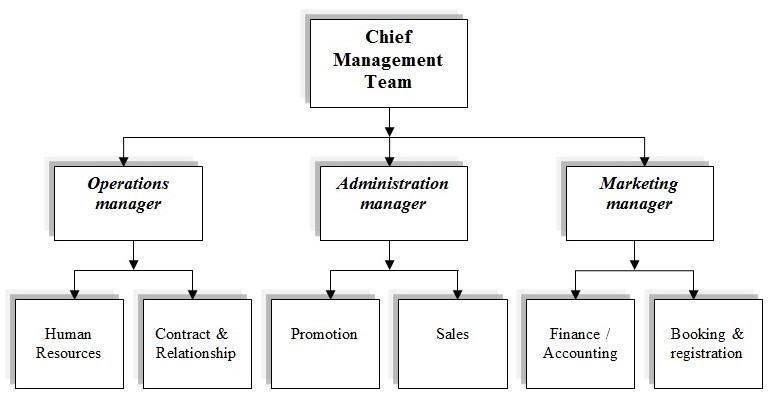
Initially the organisational structure will be simple and the chief management team (CMT) will formed by the three partners. Mainly, CMT will mange and control the company by dividing their activities in three major parts, such as, operations, marketing, and administrative departments. The company intended to introduce finance and research department within 2012. However, the figure no ten shows that it has six subdivisions to serve the company.
Reference
Bell G. H. (1997) Drive Marketing Results with Multivariable Testing Techniques. Web.
David, H. H. (2002) Entrepreneurship New Venture Creation. 6th ed. Prentice- Hall of India Private Limited
Hitt, M. A., Ireland, R. D., & Hoskisson, R. E. (2001) Strategic Management. 4th ed. South-Western Thomson Learning.
IBIS World. (2009) Household Appliance Wholesaling in Australia: Australian Industry Report. Web.
Kotler, P., & Armstrong, G. (2006) Principles of Marketing. 11th ed. Prentice-Hall of India Private Limited.
Kotler, P., & Keller, K. L. (2006) Marketing Management. 11th ed. Prentice Hall.
Mintel report (2009) Small Kitchen Appliances – UK. Web.
Pandey, I. M., (2007) Financial Management. 9th ed. Vikas publishing house Ltd
Porter, M. E., (2004) Competitive Strategy, Export Edition, New York: The Free Press
Schaper, M. & Volery, T. (2007) Entrepreneurship and small business. 2nd ed. Milton, Australia: John Wiley
